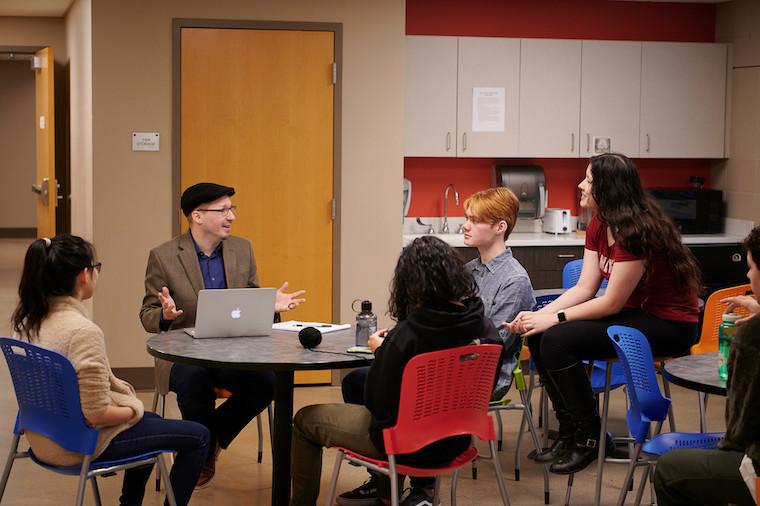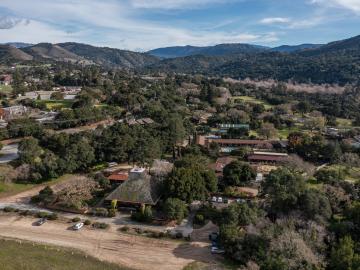Staging the Real: Workshopping Neo-Futurist Performance Art
January 31, 2020
Amanda Nagy

A new Winter Term 2020 offering this year introduced students to non-illusory performance art—an aesthetic in which performers do not pretend—culminating in a collaborative presentation of students’ own devising.
Oberlin theater alumnus Joey Rizzolo ’97 brought his expertise in Neo-Futurism to teach Staging the Real: Writing, Music Composition, and Performance. This group project invited students with a background in at least one artistic discipline, such as music composition, performance, visual art, and writing, and a willingness to explore other disciplines in a collaborative environment.
Neo-Futurism has deep Oberlin roots. Greg Allen ’84 pioneered the performance theory and founded the Neo-Futurists—an ensemble of artists who write, direct, and perform original experimental theater in the form of interactive non-fiction performance—in 1988. The Chicago and New York companies have attracted the talent of Oberlin alumni Rachel Claff ’95, Julia Melfi ’15, and Rizzolo.
Rizzolo has 25 years of teaching experience with all ages. He says he designed the course with an interdisciplinary approach, so that students could come to the creation of performance art from any artistic background.
“There are students in this course with areas of expertise which I am not familiar with at all, and they’re bringing in work that I never would have envisioned. We have a site-specific audio installation piece, and another student did a combination installation piece that incorporates video, sculpture, movement, and voices. There are a lot of different components we worked with, and the students were very ambitious about it. One of the challenges was getting them to cut down the number of things they wanted to present, because we had hours of content.”
The first two weeks of the project focused on collaborative writing and composition, in which students generated work based on specific prompts, like “create a group movement piece set to music,” “write a monologue in someone else’s voice,” and “create a piece that uses text as a key tool of communication, but none of the text is spoken.”
“Sometimes it was musical compositions, sometimes it was autobiography, choreography, or politics,” Rizzolo says. “All of these were prompts they were able to interpret however they wanted. In my experience in teaching this way, people hear a prompt and they think, ‘this is the way to execute it.’ Everyone is always surprised at how people interpret those prompts differently.”
On Jan. 31, installation pieces went on display and the students presented their short-form performance art pieces in the Kander Theater.
The project drew 16 participants. First-year Rachel Yee says she chose this project because she’s always had a passion for theater, and Neo-Futurism was something she wanted to explore.
“I'd never actually put on a play that I wrote myself, so when I saw this Winter Term project, I thought this would be a way to do that,” says Yee, a Technology in Music and Related Arts major from Delaware, Ohio.
Yee says she learned how to express herself and her experiences in terms of how she wanted the audience to experience them. “This expression can be as vivid or as vague as it needs to be as long as I'm thinking about how the audience will react, and if that reaction matches the message I'm trying to convey. If I keep this in mind while creating a piece of music, then I can effectively communicate the intent of my composition.”
Rizzolo says he was impressed with the quality and artistry of the group.
“One of the first things I asked them to do was to create a piece that required them to show off a specific skill or talent so everyone in the room could understand who they were collaborating with. We had amazing drawn visual compositions and songs written in real time. Because these students were approaching it from their own area of artistic familiarity, everything that was brought in astonished me with regard to how mature and developed it was.”
Tags:
You may also like…
Making a Difference with Business
December 10, 2024
Omukoko Okoth ’25 chose Oberlin College for its values and opportunities, and in order to take advantage of all that Oberlin has to offer, he decided to participate in the business integrative concentration.
Longtime Allen Memorial Art Museum Director Andria Derstine Announces Departure
October 14, 2024
After more than a decade of exemplary leadership, Andria Derstine is leaving her post as the John G. W. Cowles Director of the Allen Memorial Art Museum (AMAM) at Oberlin College
Oberlin Musicians Collaborate at California’s Hidden Valley Institute
February 1, 2024
Winter Term projects culminate in performances involving TIMARA, dance, chamber music, and jazz.


